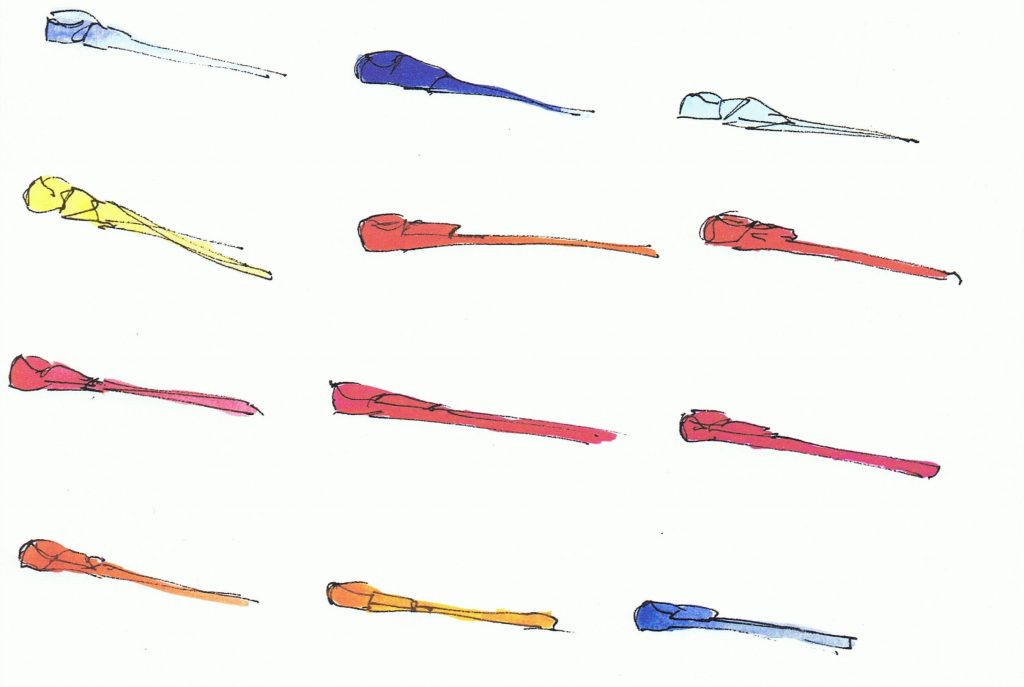
Shortly after I drew the Travelling Monument Kit I started a new sketchbook and that turned into a whole series of works, photography, drawings, sculptures and, I suppose, travel, too, all centred on swimming flippers and entitled ‘Travels with my flippers’.
The flippers became another layered metaphor, and worked for me on many levels:
The beach under the city streets…
Inspired by the writings of the Situationists International movement I have written about in a previous post, the flippers were my tool to uncovering a sense of freedom and discovery. The idea, to me at least, of a beach, a place that is wild and natural, that is hidden under the geometric grid of the urban landscape has always been an attractive one. I can imagine that at a time when industrialisation and urbanisation were rapidly increasing and cities were encroaching both in the physical sense but also in the public imagination, the idea of going to discover a beach, a place of freedom and inhibition under the concrete of the pavements, streets and plazas was a radical proposition. Not following the rules of the city, to create one’s own path and map, following the currents of the mind, the imagination is a poetic undertaking that still appeals to me, just as it did then.
Then, I actually travelled with a pair of blue rubber swimming flippers that I bought in an old department store in Nicosia and put them into various places… taking photos along the way. It was surprisingly effective in situ and made people question how they read the space.
I created a sculpture of the slippers, in white resin, and they were beautiful, glossy objects, that always looked ocean wet. To the puzzlement of many they were ‘installed’ on ordinary pavement slabs in a pristine studio space for my fine art degree show without any further explanation. It worked for me, but it didn’t work as art. The context was too obscure, the metaphors remained unexplained and inaccessible outside of their own very peculiar aesthetic.
But it didn’t matter to me at the time, because the flippers acted as a metaphorical catalyst that inspired my practice as an artist. I filled sketchbooks and rolls of film, I wrote and dreamt and thought of things. The flippers also acted as a metaphorical accelerator, something to make the worlds of dense cultural theory I was reading easier to traverse. Swimming with flippers is a great deal easier and faster, they help us adapt to an unusual environment like underwater. It felt appropriate to use them as a tool for exploring critical theory, too.
Revisiting that now I find it interesting to revisit the idea, because I still do a lot to make exploring the worlds inside my head easier, to provide myself with the appropriate context for my professional practice (even if nowadays I don’t make and draw so many things anymore).
Although much of my everyday work is now digital, I still have many material symbols of my practice… laptop stickers, sticky notes, books, journals, pens, badges, conference lanyards, drawings, charts, things on my watch (like the watch face) and so forth. Also, cables, lots of cables, and an increasing amount of debris of older devices, chargers, cable ties, hard drives etc. And alongside these objects, I make just as much effort to create the right conditions to be creative, to think about complicated things. I have a workspace full of things that help – including artworks and mementos from trips I have been on or conferences I have attended.
And often it is an object or the space I work in that help me find time to write, to draw, to think. I respect the needs of my professional practice and I think that is what those flippers were ultimately about. They were travelling companions. Companions for thinking and doing, for my practice as an artist. They were symbolic and yet entirely practical. They were totems of my professional practice.